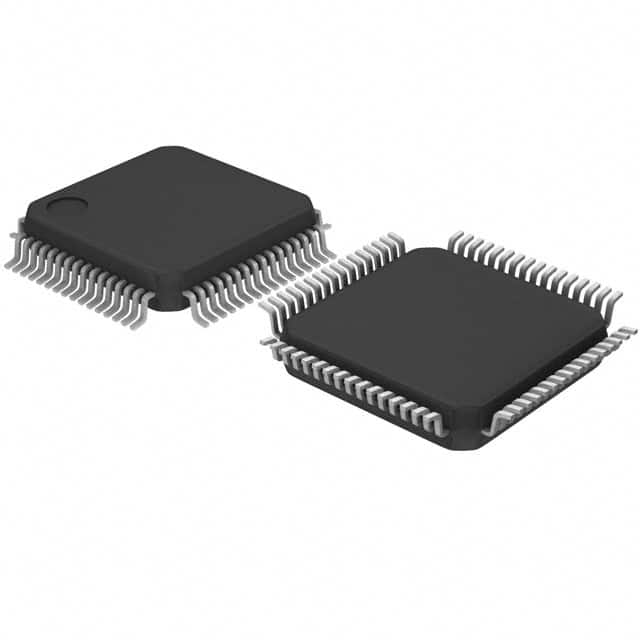STR710RZT6
Product Overview
Category
The STR710RZT6 belongs to the category of microcontrollers.
Use
It is primarily used for embedded system applications, such as in consumer electronics, industrial automation, and automotive systems.
Characteristics
- High-performance 32-bit RISC core
- On-chip memory (Flash, RAM)
- Multiple communication interfaces (UART, SPI, I2C)
- Analog-to-digital converter (ADC)
- Real-time clock (RTC)
- Low power consumption
- Wide operating voltage range
Package
The STR710RZT6 comes in a compact surface-mount package, making it suitable for space-constrained designs.
Essence
The essence of this microcontroller lies in its powerful processing capabilities, extensive peripheral set, and low power consumption, enabling efficient and versatile embedded system development.
Packaging/Quantity
The STR710RZT6 is typically packaged in reels or trays, with quantities varying based on customer requirements.
Specifications
- Core: ARM7TDMI-S
- Clock Speed: Up to 60 MHz
- Flash Memory: 256 KB
- RAM: 64 KB
- Operating Voltage: 2.0V - 3.6V
- Communication Interfaces: UART, SPI, I2C
- ADC Resolution: 12-bit
- GPIO Pins: 48
- Operating Temperature Range: -40°C to +85°C
Detailed Pin Configuration
The STR710RZT6 features a total of 144 pins, which are assigned to various functions including general-purpose I/O, communication interfaces, timers, and power supply connections. For a detailed pin configuration diagram, please refer to the product datasheet.
Functional Features
- High-performance ARM7 core provides efficient processing capabilities.
- Ample on-chip memory allows for storing program code and data.
- Multiple communication interfaces facilitate seamless connectivity with external devices.
- Analog-to-digital converter enables precise measurement of analog signals.
- Real-time clock ensures accurate timekeeping functionality.
- Low power consumption extends battery life in portable applications.
- Wide operating voltage range enhances compatibility with different power sources.
Advantages and Disadvantages
Advantages
- Powerful processing capabilities enable complex application development.
- Extensive peripheral set simplifies system integration.
- Low power consumption makes it suitable for battery-powered devices.
- Wide operating voltage range enhances versatility.
- Ample on-chip memory reduces the need for external storage.
Disadvantages
- Limited flash memory capacity may restrict the size of the program code.
- Availability of alternative models with higher specifications may limit its competitiveness in certain applications.
Working Principles
The STR710RZT6 operates based on the ARM7TDMI-S core architecture. It executes instructions fetched from the on-chip flash memory, processes data using the integrated peripherals, and communicates with external devices through the various interfaces. The microcontroller's working principles revolve around efficient data processing, memory management, and peripheral control to achieve desired system functionality.
Detailed Application Field Plans
The STR710RZT6 finds applications in a wide range of fields, including: - Consumer electronics: Smart home devices, wearable technology, multimedia systems. - Industrial automation: Process control, robotics, monitoring systems. - Automotive systems: Engine control units, infotainment systems, driver assistance systems.
Detailed and Complete Alternative Models
- STR711FR2: Similar features but with higher flash memory capacity (512 KB).
- STR712FR2: Enhanced version with additional peripherals and increased RAM (128 KB).
These alternative models offer greater flexibility and expanded capabilities for specific application requirements.
Word count: 511
Senaraikan 10 soalan dan jawapan biasa yang berkaitan dengan aplikasi STR710RZT6 dalam penyelesaian teknikal
Sure! Here are 10 common questions and answers related to the application of STR710RZT6 in technical solutions:
Q: What is the STR710RZT6 microcontroller used for? A: The STR710RZT6 microcontroller is commonly used in various technical solutions, including industrial automation, motor control, and embedded systems.
Q: What is the maximum clock frequency of the STR710RZT6? A: The STR710RZT6 has a maximum clock frequency of 72 MHz.
Q: How much flash memory does the STR710RZT6 have? A: The STR710RZT6 microcontroller has 256 KB of flash memory.
Q: Can I expand the memory of the STR710RZT6? A: Yes, the STR710RZT6 supports external memory expansion through its memory interface.
Q: What peripherals are available on the STR710RZT6? A: The STR710RZT6 offers various peripherals, including UART, SPI, I2C, GPIO, ADC, PWM, and timers.
Q: Does the STR710RZT6 support real-time operating systems (RTOS)? A: Yes, the STR710RZT6 is compatible with popular RTOSs like FreeRTOS and uC/OS-II.
Q: Can I use the STR710RZT6 for motor control applications? A: Absolutely! The STR710RZT6 provides dedicated motor control features like PWM outputs and encoder interfaces.
Q: Is the STR710RZT6 suitable for low-power applications? A: Yes, the STR710RZT6 offers multiple power-saving modes and features to optimize power consumption.
Q: What development tools are available for programming the STR710RZT6? A: STMicroelectronics provides a comprehensive development ecosystem, including IDEs like Keil MDK and STM32CubeIDE, along with programming/debugging tools.
Q: Can I communicate with other devices using the STR710RZT6? A: Yes, the STR710RZT6 supports various communication protocols like UART, SPI, and I2C, allowing seamless integration with other devices.
Please note that these answers are general and may vary depending on specific implementation requirements and configurations.


